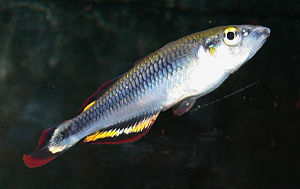Bedotia madagascariensis
| Bedotia madagascariensis | ||||||||||||
|---|---|---|---|---|---|---|---|---|---|---|---|---|

Bedotia madagascariensis |
||||||||||||
| Systematics | ||||||||||||
|
||||||||||||
| Scientific name | ||||||||||||
| Bedotia madagascariensis | ||||||||||||
| Regan , 1903 |
Bedotia madagascariensis is afish endemic to Madagascar and a type species of the genus Bedotia . It was firstintroduced in Europe in1953 for aquarium purposes. B. madagascariensis is often referred toas Madagascar earfish or redtail earfish, but these names are not entirely clear and sometimes also refer to the similarly appearing species Bedotia geayi, which is also kept in aquariums.
distribution and habitat
The distribution area of B. madagascariensis extends in eastern Madagascar from the lower reaches of the Ivoloina, a river north of Toamasina , to the south to at least the Manambolo, a stream near Vatomandry . In the 1950s, successful attempts to settle in the upper reaches of the Betsiboka were made so that the species is now presumably native to the entire Betsiboka Basin.
The original habitat of this species are clear flowing waters, at least partially shaded by vegetation. The composition of the riparian vegetation is of secondary importance, its function as providing shade is essential. These waters on the eastern slopes of Madagascar are generally very soft with a water hardness of less than 17.1 ppm . The species is also found in typical blackwater habitats that are very acidic , with a pH of up to 4.8 , such as swamps. Brackish water is avoided by B. madagascariensis although animals in captivity show a certain salinity tolerance. The preferred location are areas with little flow.
Appearance
In captivity, B. madagascariensis can reach a standard length of ten centimeters, while wild animals are likely to remain somewhat smaller. Its body, covered with large round scales , is relatively elongated, somewhat stronger in the front part. The stomach and back lines are slightly curved. Its jaws have four to six rows of small and strongly curved, single-pointed teeth. The lower jaw protrudes slightly. B. madagascariensis has two dorsal fins, the first of which is supported by four to five weak hard rays, the second by ten to twelve soft rays. Of these, the first four or five rays are undivided. The anal fin has 14 to 17 soft rays of which the first three to four are undivided. The short and high standing pectoral fins have twelve soft rays. The ventral fins are each equipped with a hard ray and five divided soft rays.
B. madagascariensis shows a pronounced sexual dimorphism , especially in the pattern of the unpaired fins. In the male, the first dorsal and pelvic fins are darkly rimmed and have a transparent to metallic golden yellow color at the base. The base of the second dorsal fin is golden yellow, its edge shows a black, outwardly dark red edge. The anal fin is similarly colored, but also has a black stripe at the base. A dark band on the sides of the body continues somewhat in the caudal fin and is surrounded there by a silver-white to golden-yellow halo. The distal corners of the slightly notched caudal fin are either dark red or iridescent white. The transparent pectoral fins have a dark point at the top. In some males, all of the unpaired fins are uniformly red or black. Female B. madagascariensis have less conspicuously marked fins. Your first dorsal fin is yellowish transparent at the base and becomes darker towards the outer edge. The second dorsal fin is bordered whitish yellow and black and white. The anal fin is similarly colored, but still shows a dark band close to the body. The continuation of the collateral ligament on the caudal fin is surrounded by a transparent surface that is delimited by a dark drawing. The outer corners of the caudal fin are translucent yellow to white. The pectoral fins are completely transparent.
behavior
B. madagascariensis lives in loose swarms of a few dozen animals, staggered according to size. Younger animals mainly stay in shallow areas, while adult specimens often seek out deeper water. Little is known about its reproductive behavior in the wild. However, wild catches of individuals of various sizes and ages and experience with the growth rates of fish in captivity suggest an extended breeding season. B. madagascariensis prey on a number of predators , in addition to piscivorous waders and the Madagascar dwarf fishers ( Alcedo vintsioides ) also cichlids from the genus Paratilapia , representatives of the flagtails ( Kuhlia ), the tiger fish Mesopristes elongatus and the goby Glossogobius giuris . Since the introduction of the snakehead fish Channa maculata to Madagascar in 1978, another predator has been added. Despite its small size, the species is caught by local fisheries in most of the range. In captivity, B. madagascariensis can reach an age of ten years, but the high feeding pressure makes a comparable longevity for wild animals appear unlikely.
status
Due to the distribution as aquarium fish and the associated commercial reproduction, there is no immediate risk of the species disappearing. However, the progressive habitat destruction in its natural range and the increasing distribution of neozoa , and especially the snakehead fish Channa maculata , pose serious problems. The IUCN lists B. madagascariensis as near threatened ("low risk").
swell
literature
- Paul Loiselle, Damaris Rodriguez: A new species of Bedotia (Teleostei: Atherinomorpha: Bedotiidae) from the Rianila drainage of Eastern Madagascar, with redescriptions of Bedotia madagascariensis and Bedotia geayi . In: Zootaxa . No. 1520, 2007, ISSN 1175-5326 (print) ISSN 1175-5334 (online), pp. 1–18 ( PDF, 390 kB )
Web links
- Bedotia madagascariensis on Fishbase.org (English)
- Bedotia madagascariensis in the endangered Red List species the IUCN 2007. Posted by: Loiselle, P. & participants of the CBSG / ANGAP CAMP "Faune de Madagascar" workshop, Mantasoa, Madagascar 2001, 2004. Accessed on March 16 of 2008.